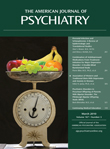Abstract
Objective
Key biological factors that influence the development of depression are modified by diet. This study examined the extent to which the high-prevalence mental disorders are related to habitual diet in 1,046 women ages 20–93 years randomly selected from the population.
Method
A diet quality score was derived from answers to a food frequency questionnaire, and a factor analysis identified habitual dietary patterns. The 12-item General Health Questionnaire (GHQ-12) was used to measure psychological symptoms, and a structured clinical interview was used to assess current depressive and anxiety disorders.
Results
After adjustments for age, socioeconomic status, education, and health behaviors, a "traditional" dietary pattern characterized by vegetables, fruit, meat, fish, and whole grains was associated with lower odds for major depression or dysthymia and for anxiety disorders. A "western" diet of processed or fried foods, refined grains, sugary products, and beer was associated with a higher GHQ-12 score. There was also an inverse association between diet quality score and GHQ-12 score that was not confounded by age, socioeconomic status, education, or other health behaviors.
Conclusions
These results demonstrate an association between habitual diet quality and the high-prevalence mental disorders, although reverse causality and confounding cannot be ruled out as explanations. Further prospective studies are warranted.



